enrollment
Nearly Half of Graduate Enrollment Leads Come From Digital Sources
Graduate marketing and recruitment has been in the midst of dramatic change over the last few years—long before the pandemic forced even more change on our institutions. Perhaps nothing describes that better than on particular result from our recent poll of more than 180 graduate programs across the nation: respondents (on average) indicated that almost half (47 percent) of their graduate enrollment leads now come from digital advertising or SEO/organic lead generation.
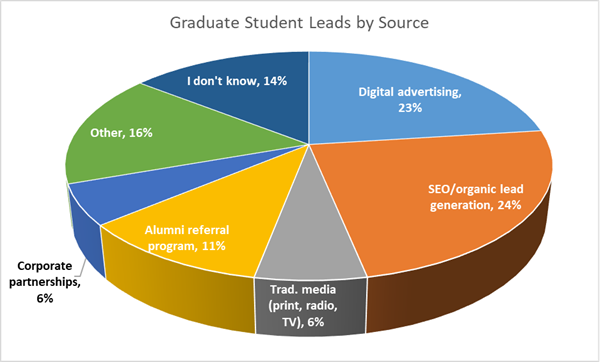
As recently as two years ago, I found fairly significant skepticism of these marketing channels when I was working with campuses and programs, often due to what they saw as low conversion rates. A couple of years later—and a lifetime of learning how you effectively convert these types of leads—they are quickly taking over from both more traditional media and more traditional practices such as alumni referral, corporate partnerships, and answering a call from someone looking for your program.
Tracking graduate enrollment leads
Graduate recruitment and marketing professionals have also become far more sophisticated in how they track their graduate enrollment leads, with only 6 percent indicating that they don’t track the sources of their leads. When asked the extent to which they were confident in their tracking data, almost one-quarter were very confident, and about one-in-five were not very confident. This may not seem as good as it is. Again, as recently as two years ago, I regularly encountered programs that were keeping no such records—the data just were not there (one of the reasons we didn’t do this poll two years ago!).
| How confident are you in your tracking of lead generation by source of lead? | Percent |
| Very confident in the data | 23.1% |
| Somewhat confident in the data | 50.8% |
| Not very confident in the data | 20.7% |
| We do not track leads by sources/I don’t know the source of leads | 6.1% |
Talk with our graduate and online enrollment experts
Ask for a free consultation with us. We’ll help you assess your market and develop the optimal strategies for your prospective graduate students and online learners.
Allocating marketing dollars
A broad range of stakeholders are familiar with these data on graduate conversions. More than half of respondents were graduate enrollment leaders/professionals, one-quarter were heads of a graduate school or specific programs, and 15 percent were graduate-level marketers. When we asked about the proportion of the marketing budget was being spent on lead generation versus lead nurturing, 30 percent did not know—perhaps because of the relatively small proportion of respondents who were marketers. This may indicate that some proportion of enrollment leaders (more than half of respondents) are not sure how the marketing budget is being spent. IF this is so, it is something that all enrollment stakeholders need to be well versed in.
There is a fairly considerable imbalance in how marketing dollars are spent, with more than twice the proportion of the total budget being spent on lead generation than on lead nurturing. This is something that institutions would be wise to address. The cultivation of those that are already in the funnel (lead nurturing) is the single greatest way to control overall marketing costs (in my opinion). Every prospective student you can keep in the “funnel” is one that you don’t have to generate anew with more lead generation dollars. In some cases, nurturing is not part of the marketing budget, and that reality may be being portrayed in these data, but it is important to view this holistically in order to maximize the ROI of marketing dollars.
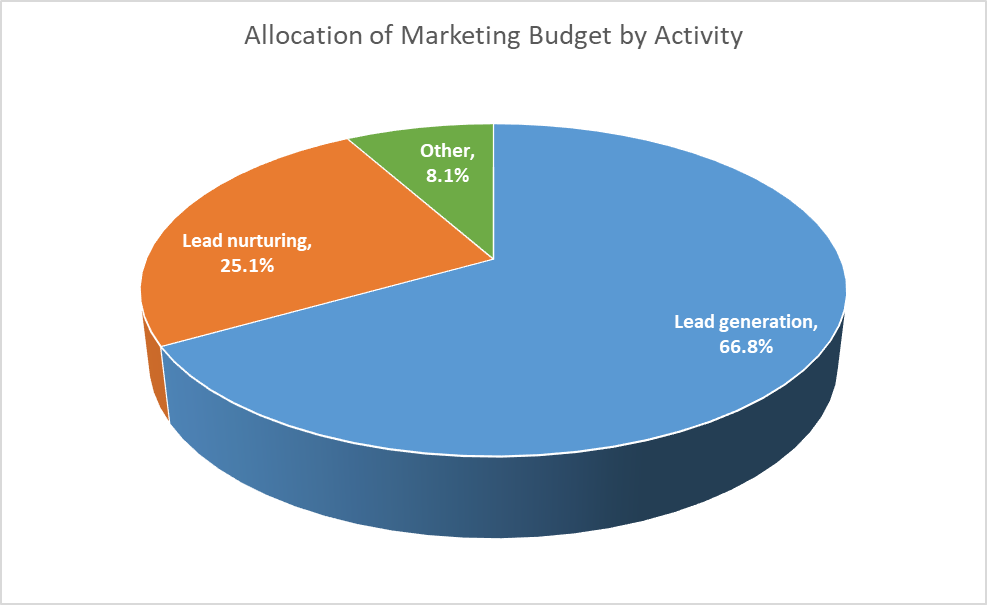
Marketing budgets by lead source
Digital marketing techniques now comprise the largest proportion of the typical graduate level marketing budget. Respondents report that, on average, 48 percent of their budget is dedicated to digital advertising and another 21 percent is spent on SEO/organic lead generation. It was amazing to me—after working with so many graduate schools over the last two decades, that less than 15 percent of the marketing budget is now spent on traditional advertising (print, radio, tv, etc.).
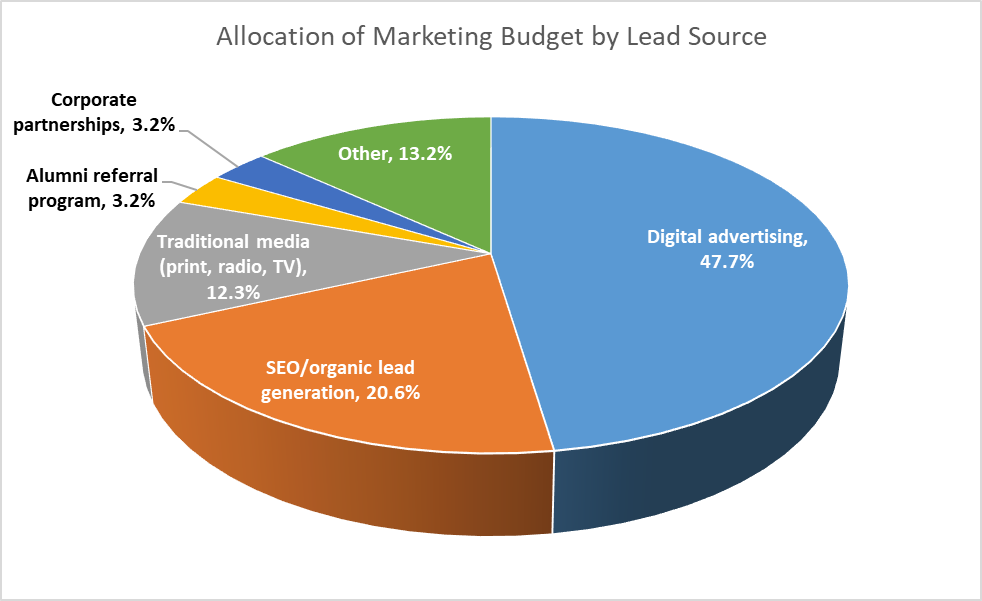
While these media continue to work well for many schools, it is often difficult to track their ROI, and as such—when every dollar counts more than ever before—graduate programs are increasingly turning to digital sources. One respondent commented that:
“We focus on digital because we can monitor it in real-time, make adjustments on the fly, and this all allows us to max out our ROI in a way that we never could when we were still wrapping buses and advertising in the Higher Education supplement“
Conversion rates by stage
The typical conversion rate from first inquiry to enrollment among our responding graduate schools is 30 percent. Respondents indicate similar conversion from first contact to application, but then much stronger conversion (60 percent) from completed application to acceptance, and even stronger (64 percent) from accepted to enrollment. At each stage, conversion rates are highest when schools and programs are targeting the right prospective students. While there are a myriad of elements to getting this right, the targeting tools available to digital marketers today are getting more and more sophisticated and are contributing toward connecting with the right students in ways that more traditional media channels simply cannot match.
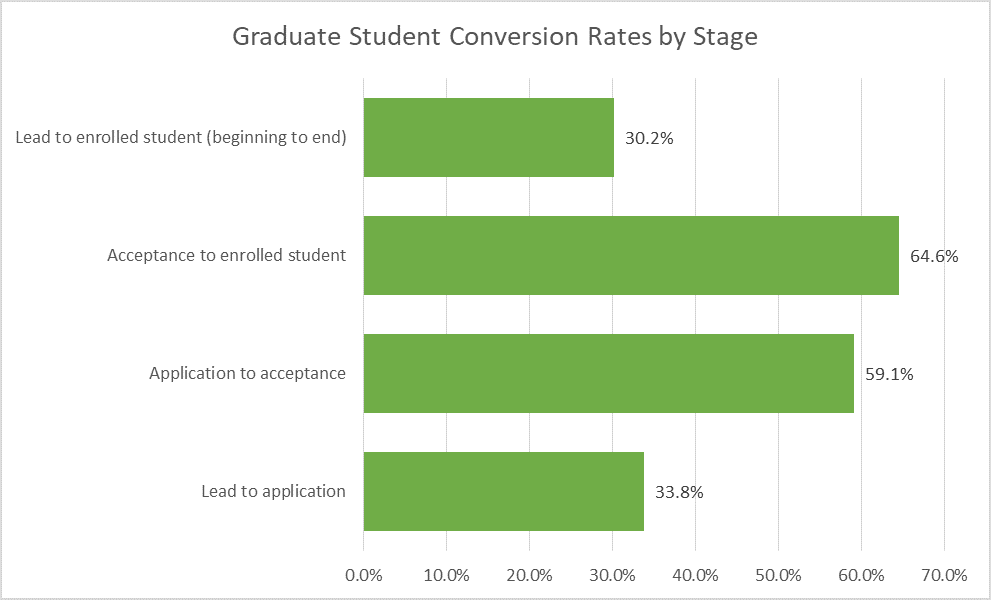
One of the complications of conducting a poll like this is that different graduate programs convert at vastly different rates. In order to address this, we asked respondents if some programs convert at different rates than others. We were not surprised that 91 percent of respondents indicated that this was true—and among the 9 percent that didn’t, I would note that half only have one program or cluster of programs.
What were the programs that converted at the highest rates? While more than 100 programs were cited—ranging from Business to IT to Religious Studies, respondents most frequently cited Business Administration programs (28), followed by Education (17) and Nursing (12). Rounding out the top five were Business master’s programs and Counseling programs, each cited by 6 respondents.
Graduate revenue as portion of total
If the early data being reported on fall 2020 enrollment showing surprising graduate growth prove to be a real trend, and if graduate programs grow in the wake of the recession that is coming (as they have in past recessions), graduate program revenue is likely to increase from the current average of 31 percent of total institutional revenue. Currently only about one-quarter of responding institutions contribute more than 50 percent of total institutional revenue, but we may see our graduate programs becoming even more critical to institutional success than they have been over the last decade. These data provide me with even more confidence that the hard working graduate enrollment and marketing leaders that I know and respect are up to the challenge.
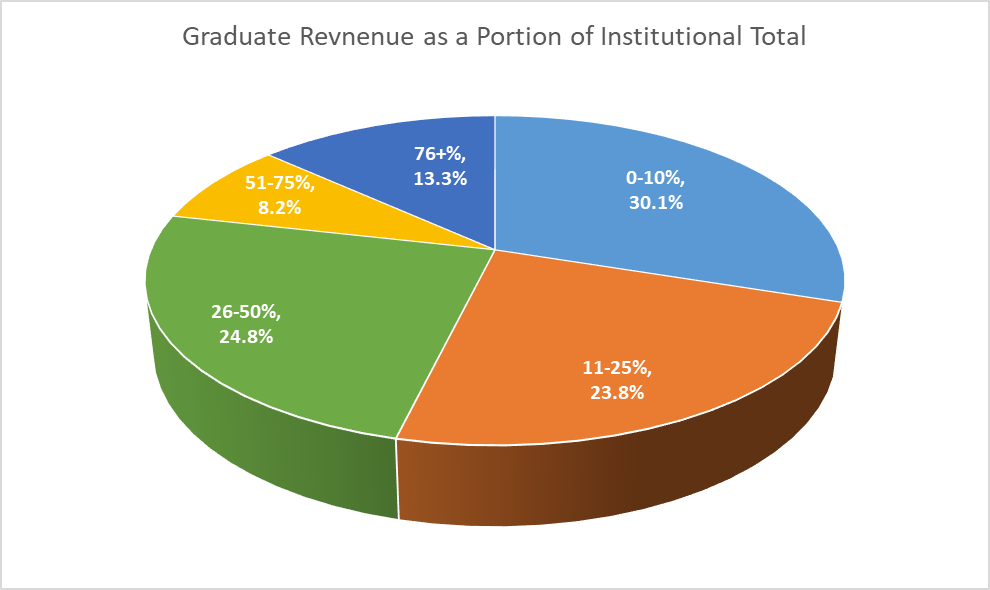
| Respondent Title | Percent |
| Institutional Leader (President/Provost, etc.) | 2.1% |
| Dean/Head Graduate School | 15.5% |
| Graduate Program Director | 11.2% |
| Enrollment Professional (specific program/school) | 17.6% |
| Enrollment Professional (all graduate programs) | 39.0% |
| Marketing professional (all graduate programs) | 9.1% |
| Marketing professional s(specific program/school) | 5.3% |
Let’s discuss how you can optimize your graduate student leads

My colleagues and I are working with graduate and professional programs around the country, and we would be happy to chat with you about how you can engage more graduate leads through digital channels. Contact us today and we’ll set up a convenient time to talk.
